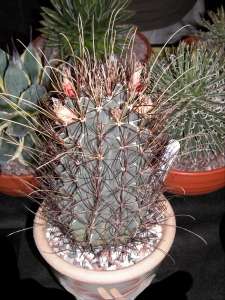(part two)
- Thelocactus
- Coryphantha
(follow the links to go to other pictures in the 'Northants News @ the National' site)

| Ian Priestleys Coryphanthanae Report
from the BCSS National Show 2004
(part two)
(follow the links to go to other pictures in the 'Northants News @ the National' site) |
|
The Thelocactus in Class 53, was surprisingly quite poorly supported, with only eight entries. The advantages of this genus have been well documented/publicised previously by the Mammillaria Society amongst others, but perhaps to little avail?
The first prize winner was a ten inch Glandulicactus uncinatus, (pictured above) topped with four inch hooked spines. (T.W) A repotting nightmare!
| T. rinconensis (under this name, nidulans, lophothele or phymatothele) was the most popular species, with two plants filling approx 12 pans allowing for the spines. The two-headed plant on the right was third in the class. There was a 7 pot of T. conothelos var. auriantacus this plant being about 12 in height, 5 diameter with 4 offsets. Finally a two headed T. hastifer in a 5 pot, the longest head being about 10-12 long, creeping over the side of the pot by about 3. |
|
There were only 2 classes for the Coryphantha Group: Class 11 (one plant) had only a disappointing 6 entries why is this such a Cinderella genus? Perhaps growers are put off by their relatively slow growth and susceptibility to red spider mite attack?
|
|
The
winner was an 8 pan of Escobaria (Coryphantha) minima
(left) followed by a lovely, large (14-15) pan of C. cornifera,
(pictured
below) with nine heads. Third went to a 10
pan of E. roseana, the original not the new small form, which is now
transferred to E. achemea.
Some other exhibits were the two HC commended Escobaria leei - 10 pan and C. andreae, the final plant being a nice 7 pan of E. tuberculosa. |
|
Class 12 for Two Coryphanthas, (max 130mm), had a bit more interest but still with only 8 entries. Pat Mills showed a 5 potted pair of C. elephantidens (under the name greenwoodiae) and C. scheeri var. valida, to take first place and J. Cooke scooped second with his C. hesteri (5 pan) and a smaller C. Sp? Of the rest, there were various combinations of Escobaria and Coryphantha including some very fine plants. There is little to quibble with the quality of the judging. I had no argument with any of the placings, which seemed fine. I do offer my sympathy though, for the poor judge(s) who has only a limited time to make all these finer distinctions. |
Coryphantha cornifera, second in class 11. |
More of my Mammillaria pictures are on the next page. Click 'Six of the best'
Ian Priestley
Back to PART ONE of this report (the Mammillarias)